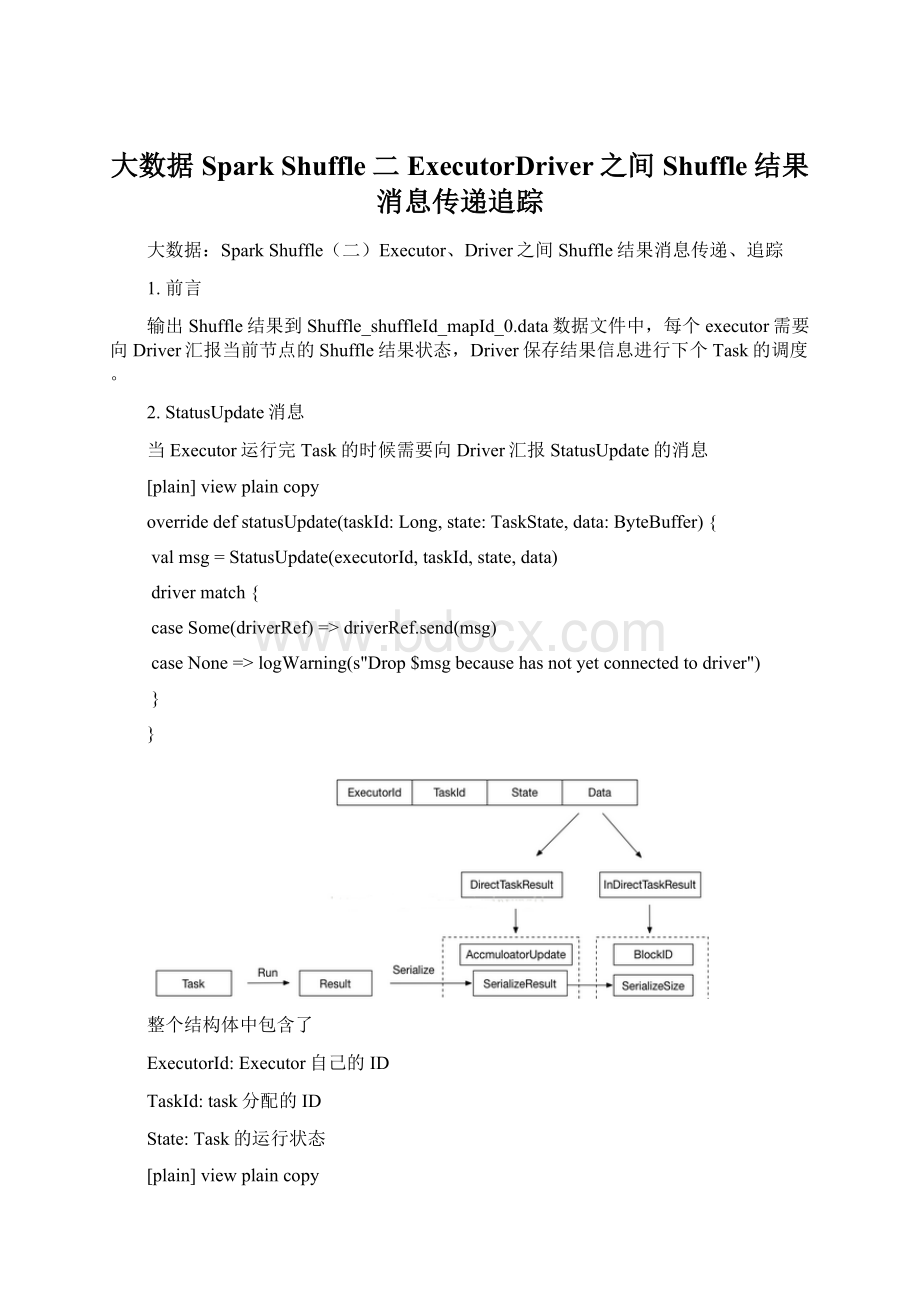大数据Spark Shuffle二ExecutorDriver之间Shuffle结果消息传递追踪.docx
《大数据Spark Shuffle二ExecutorDriver之间Shuffle结果消息传递追踪.docx》由会员分享,可在线阅读,更多相关《大数据Spark Shuffle二ExecutorDriver之间Shuffle结果消息传递追踪.docx(15页珍藏版)》请在冰豆网上搜索。

大数据SparkShuffle二ExecutorDriver之间Shuffle结果消息传递追踪
大数据:
SparkShuffle
(二)Executor、Driver之间Shuffle结果消息传递、追踪
1.前言
输出Shuffle结果到Shuffle_shuffleId_mapId_0.data数据文件中,每个executor需要向Driver汇报当前节点的Shuffle结果状态,Driver保存结果信息进行下个Task的调度。
2.StatusUpdate消息
当Executor运行完Task的时候需要向Driver汇报StatusUpdate的消息
[plain]viewplaincopy
overridedefstatusUpdate(taskId:
Long,state:
TaskState,data:
ByteBuffer){
valmsg=StatusUpdate(executorId,taskId,state,data)
drivermatch{
caseSome(driverRef)=>driverRef.send(msg)
caseNone=>logWarning(s"Drop$msgbecausehasnotyetconnectedtodriver")
}
}
整个结构体中包含了
ExecutorId:
Executor自己的ID
TaskId:
task分配的ID
State:
Task的运行状态
[plain]viewplaincopy
LAUNCHING,RUNNING,FINISHED,FAILED,KILLED,LOST
Data:
保存序列化的Result
2.1Executor端发送
在Task运行后的结果,Executor会将结果首先序列化成ByteBuffer封装成DirectTaskResult,再次序列化DirectTaskResult成ByteBuffer,很显然序列化的结果的大小会决定不同的传递策略。
在这里会有两个筏值来控制
最大的返回结果大小,如果超过设定的最大返回结果时,返回的结果内容会被丢弃,只是返回序列化的InDirectTaskResult,里面包含着BlockID和序列化后的结果大小
[plain]viewplaincopy
spark.driver.maxResultSize
最大的直接返回结果大小:
如果返回的结果大于最大的直接返回结果大小,小于最大的返回结果大小,采用了保存的折中的策略,将序列化DirectTaskResult保存到BlockManager中,关于BlockManager可以参考前面写的BlockManager系列,返回InDirectTaskResult,里面包含着BlockID和序列化的结果大小
[plain]viewplaincopy
spark.task.maxDirectResultSize
直接返回:
如果返回的结果小于等于最大的直接返回结果大小,将直接将序列化的DirectTaskResult返回给Driver端
[plain]viewplaincopy
valserializedResult:
ByteBuffer={
if(maxResultSize>0&&resultSize>maxResultSize){
logWarning(s"Finished$taskName(TID$taskId).ResultislargerthanmaxResultSize"+
s"(${Utils.bytesToString(resultSize)}>${Utils.bytesToString(maxResultSize)}),"+
s"droppingit.")
ser.serialize(newIndirectTaskResult[Any](TaskResultBlockId(taskId),resultSize))
}elseif(resultSize>maxDirectResultSize){
valblockId=TaskResultBlockId(taskId)
env.blockManager.putBytes(
blockId,
newChunkedByteBuffer(serializedDirectResult.duplicate()),
StorageLevel.MEMORY_AND_DISK_SER)
logInfo(
s"Finished$taskName(TID$taskId).$resultSizebytesresultsentviaBlockManager)")
ser.serialize(newIndirectTaskResult[Any](blockId,resultSize))
}else{
logInfo(s"Finished$taskName(TID$taskId).$resultSizebytesresultsenttodriver")
serializedDirectResult
}
}
2.2Driver端接收
Driver端处理StatusUpdate的消息的代码如下:
[plain]viewplaincopy
caseStatusUpdate(executorId,taskId,state,data)=>
scheduler.statusUpdate(taskId,state,data.value)
if(TaskState.isFinished(state)){
executorDataMap.get(executorId)match{
caseSome(executorInfo)=>
executorInfo.freeCores+=scheduler.CPUS_PER_TASK
makeOffers(executorId)
caseNone=>
//Ignoringtheupdatesincewedon'tknowabouttheexecutor.
logWarning(s"Ignoredtaskstatusupdate($taskIdstate$state)"+
s"fromunknownexecutorwithID$executorId")
}
}
scheduler实例是TaskSchedulerImpl.scala
[plain]viewplaincopy
if(TaskState.isFinished(state)){
cleanupTaskState(tid)
taskSet.removeRunningTask(tid)
if(state==TaskState.FINISHED){
taskResultGetter.enqueueSuccessfulTask(taskSet,tid,serializedData)
}elseif(Set(TaskState.FAILED,TaskState.KILLED,TaskState.LOST).contains(state)){
taskResultGetter.enqueueFailedTask(taskSet,tid,state,serializedData)
}
}
statusUpdate函数调用了enqueueSuccessfulTask方法
[plain]viewplaincopy
defenqueueSuccessfulTask(
taskSetManager:
TaskSetManager,
tid:
Long,
serializedData:
ByteBuffer):
Unit={
getTaskResultExecutor.execute(newRunnable{
overridedefrun():
Unit=Utils.logUncaughtExceptions{
try{
val(result,size)=serializer.get().deserialize[TaskResult[_]](serializedData)match{
casedirectResult:
DirectTaskResult[_]=>
if(!
taskSetManager.canFetchMoreResults(serializedData.limit())){
return
}
//deserialize"value"withoutholdinganylocksothatitwon'tblockotherthreads.
//Weshouldcallithere,sothatwhenit'scalledagainin
//"TaskSetManager.handleSuccessfulTask",itdoesnotneedtodeserializethevalue.
directResult.value(taskResultSerializer.get())
(directResult,serializedData.limit())
caseIndirectTaskResult(blockId,size)=>
if(!
taskSetManager.canFetchMoreResults(size)){
//droppedbyexecutorifsizeislargerthanmaxResultSize
sparkEnv.blockManager.master.removeBlock(blockId)
return
}
logDebug("FetchingindirecttaskresultforTID%s".format(tid))
scheduler.handleTaskGettingResult(taskSetManager,tid)
valserializedTaskResult=sparkEnv.blockManager.getRemoteBytes(blockId)
if(!
serializedTaskResult.isDefined){
/*Wewon'tbeabletogetthetaskresultifthemachinethatranthetaskfailed
*betweenwhenthetaskendedandwhenwetriedtofetchtheresult,orifthe
*blockmanagerhadtoflushtheresult.*/
scheduler.handleFailedTask(
taskSetManager,tid,TaskState.FINISHED,TaskResultLost)
return
}
valdeserializedResult=serializer.get().deserialize[DirectTaskResult[_]](
serializedTaskResult.get.toByteBuffer)
//forcedeserializationofreferencedvalue
deserializedResult.value(taskResultSerializer.get())
sparkEnv.blockManager.master.removeBlock(blockId)
(deserializedResult,size)
}
//Setthetaskresultsizeintheaccumulatorupdatesreceivedfromtheexecutors.
//Weneedtodothishereonthedriverbecauseifwedidthisontheexecutorsthen
//wewouldhavetoserializetheresultagainafterupdatingthesize.
result.accumUpdates=result.accumUpdates.map{a=>
if(a.name==Some(InternalAccumulator.RESULT_SIZE)){
valacc=a.asInstanceOf[LongAccumulator]
assert(acc.sum==0L,"taskresultsizeshouldnothavebeensetontheexecutors")
acc.setValue(size.toLong)
acc
}else{
a
}
}
scheduler.handleSuccessfulTask(taskSetManager,tid,result)
}catch{
casecnf:
ClassNotFoundException=>
valloader=Thread.currentThread.getContextClassLoader
taskSetManager.abort("ClassNotFoundwithclassloader:
"+loader)
//MatchingNonFatalsowedon'tcatchtheControlThrowablefromthe"return"above.
caseNonFatal(ex)=>
logError("Exceptionwhilegettingtaskresult",ex)
taskSetManager.abort("Exceptionwhilegettingtaskresult:
%s".format(ex))
}
}
})
}
在函数中,反序列化的过程是通过线程池里的线程来运行的,Netty的接收数据线程是不能被堵塞(同时还接受着别的消息),反序列化是耗时的任务,不能在Netty的消息处理线程中运行。
2.2.1DirectTaskResult处理过程
直接反序列化成DirectTaskResult,反序列化后进行了整体返回内容的大小的判断,在前面的2.1中介绍参数:
spark.driver.maxResultSize,这个参数是Driver端的参数控制的,在Spark中会启动多个Task,参数的控制是一个整体的控制所有的Tasks的返回结果的数量大小,当然单个task使用该筏值的控制也是没有问题,因为只要有一个任务返回的结果超过maxResultSize,整体返回的数据也会超过maxResultSize。
对DirectTaskResult里的result进行了反序列化。
2.2.2InDirectTaskResult处理过程
通过size判断大小是否超过spark.driver.maxResultSize筏值控制
通过BlockManager来获取BlockID的内容反序列化成DirectTaskResult
对DirectTaskResult里的result进行了反序列化
最后调用handleSuccessfulTask方法
[plain]viewplaincopy
sched.dagScheduler.taskEnded(tasks(index),Success,result.value(),result.accumUpdates,info)
回到了Dag的调度,向eventProcessLoop的队列里提交了CompletionEvent的事件
[plain]viewplaincopy
deftaskEnded(
task:
Task[_],
reason:
TaskEndReason,
result:
Any,
accumUpdates:
Seq[AccumulatorV2[_,_]],
taskInfo:
TaskInfo):
Unit={
eventProcessLoop.post(
CompletionEvent(task,reason,result,accumUpdates,taskInfo))
}
处理eventProcessLoop队列的event是在DAG的线程处理的,在这里我们不讨论DAG的任务调度。
2.3MapOutputTracker
MapOutputTracker是当运行完ShuffleMapTask的时候,ShuffleWrite会生成Shuffle_shuffleId_mapId_0.data、index文件,Executor需要将具体的信息返回给Driver,当Driver进行下一步的Task运算的时候,Executor也需要获取具体Shuffle数据文件的信息进行下一步的action算子的运算,结构的保存、管理就是通过MapOutputTracker跟踪器进行追踪的。
2.3.1RegisterMapOutput
Execute端
在ShuffleMapTask中运行后会生成一个MapStatus,也就是上图的Map0结构,ComressedMapStatus、HighlyCompressedMapStatus这里的两个区别主要是增对Partition1...的sizelong的压缩,但这里的压缩算法并不准确比,如CompressedMapStatus的算法:
[plain]viewplaincopy
defcompressSize(size:
Long):
Byte={
if(size==0){
0
}elseif(size<=1L){
1
}else{
math.min(255,math.ceil(math.log(size)/math.log(LOG_BASE)).toInt).toByte
}
}
求Log1.1(size)的整数转为byte,也就是支持最大1.1^255=35G左右
为何不需要计算精准的尺寸?
还记得前面博客里提到的Shuffle_shuffleId_mapId_reduceId.index文件么,这里才是精准的位置,当读取本地文件的时候,并不使用MapStatus里的Size
Size有何用?
有存在别的Execute获取别的Execute的Shuffle结果文件,此时的size是获取文件的大概位置。
MapStatus是ShuffleMapTask运行的结果,被序列化成DirectTaskResult中的value,通过StatusUpdate消息传递
Driver端
DAG线程调度处理CompletionEvent的事件
[plain]viewplaincopy
private[scheduler]defhandleTaskCompletion(event:
CompletionEvent){
............
casesmt:
ShuffleMapTask=>
valshuffleStage=stage.asInstanceOf[ShuffleMapStage]
updateAccumulators(event)
valstatus=event.result.asInstanceOf[MapStatus]
valexecId=atus.location.executorId
logDebug("ShuffleMapTaskfinishedon"+execId)
if(failedEpoch.contains(execId)&&smt.epoch<=failedEpoch(execId)){
logInfo(s"Ignoringpossiblybogus$smtcompletionfromexecutor$execId")
}else{
shuffleStage.addOutputLoc(smt.partitionId,status)
}
if(runningStages.contains(shuffleStage)&&shuffleStage.pendingPartitions.isEmpty){
markStageAsFinished(shuffleStage)
logInfo("lookingfornewlyrunnablestages")
logInfo("running:
"+runningStages)
logInfo("waiting:
"+waitingStages)
logInfo("failed:
"+failedStages)
//Wesupplytruetoincrementtheepochnumberhereincasethisisa
//recomputationofthemapoutputs.Inthatcase,somenodesmayhavecached
//locationswithholes(fromwhenwedetectedtheerror)andwillneedthe
//epochincrementedtorefetchthem.
//TODO:
Onlyincrementtheepochnumberifthisisnotthefirsttime
//weregisteredthesemapoutputs.
mapOutputTracker.registerMapOutputs(
shuffleStage.shuffleDep.shuffleId,
shuffleStage.outputLocInMapOutputTrackerFormat(),
changeEpoch=true)
clearCacheLocs()
if(!
shuffleStage.isAvailable){
//Som